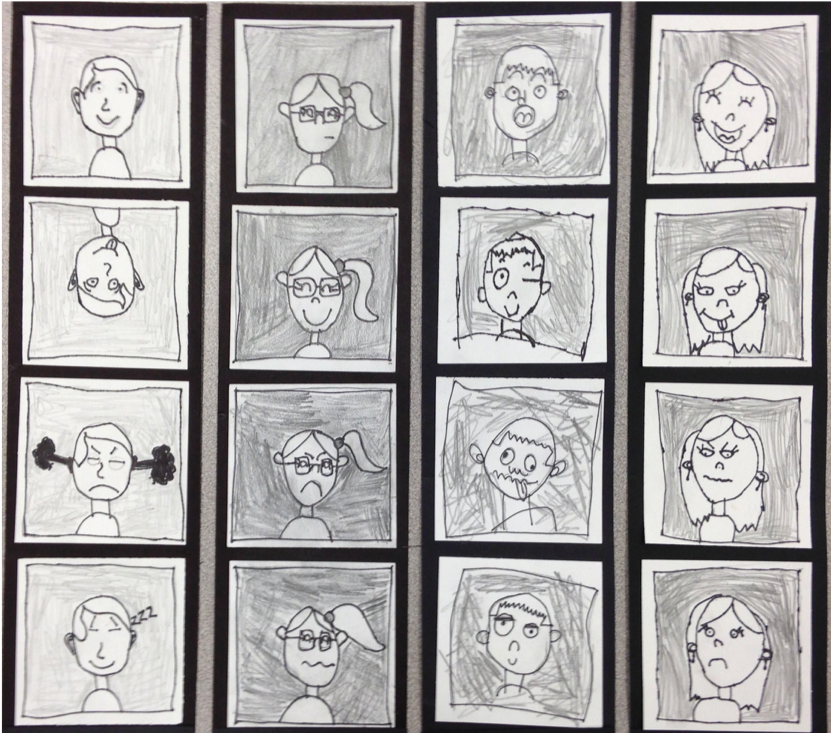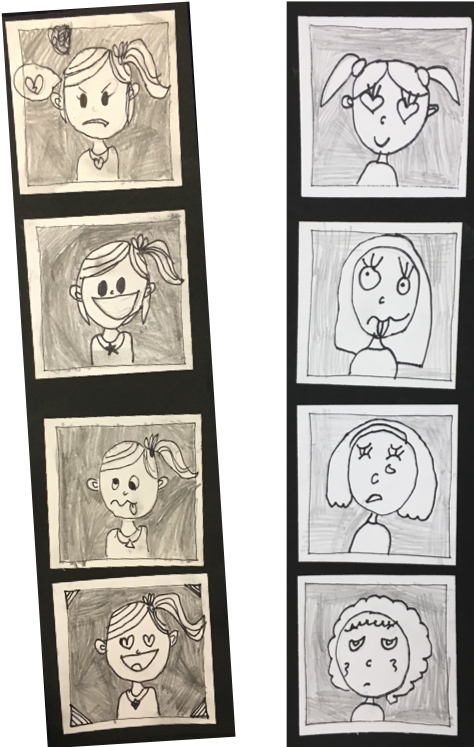If you ask a group of first graders about emotions and feelings, they can usually name a few. “Happy! Sad! Sleepy? Mad!” You might even get a few precocious answers like “Flabbergasted” or “Timid.” Even if students can name emotions, they are still learning what it means to feel those emotions. In the art classroom, one way students can safely explore those feelings is through self-portraits.
What is Self-Awareness?
As human beings, we experience a wide range of emotions every day, and sometimes these emotions vary from minute to minute. Individuals who can identify and articulate their feelings are more apt to understand the cause of their emotions. They can learn to process and manage their personal responses to situations. This is self-awareness.
The Collaborative for Academic, Social, and Emotional Learning (CASEL) argues that self-awareness is a core competency for human development. CASEL defines self-awareness as “the ability to understand one’s own emotions, thoughts, and values and how they influence behavior across contexts.” The art room provides the opportunity to explore a student’s strengths, growth areas, and personal voice. In essence, the art room fosters self-awareness.

Creating a self-portrait can lead to a heightened sense of awareness of one’s physical appearance. There is the shape of the eyes, the nose, the curve of the lips, the hairstyle. But, what about the expression depicted on the face? Young students know their audience (grandma, a teacher, a parent, etc.) desires nothing more than a happy, smiley self-portrait to display. We all love those smiling faces. However, unique expressions are an essential aspect of being human, and studying those expressions can lead to a stronger sense of self.
Identify and label emotions.
Begin by brainstorming a list of feelings with the class. What emotions have they experienced or recognized on the faces of others? Upon identifying an emotion, students can contort their own faces into the different expressions they describe. Invite students to notice how their face feels when they act out a different feeling. What are their eyebrows doing, or the curve of their lips?

After students identify their own feelings, explore the same concept through observation and analysis of artworks. The art world is full of endless examples of portraits in which the subject portrays raw human emotion. Lead students through a discussion of observed emotion while viewing a collection of projected images. Additionally, they could sort printed images of facial expressions into piles of happy, sad, grumpy, determined, etc.
Create drawn photo strips.
These discussions lead to many creative and expressive artmaking experiences. One such final product is a drawn self-portrait that resembles a photo strip where each of the four images depicts a different emotion. The discussions and artmaking process can be modified for any grade level by establishing expectations that meet student needs and abilities.
The Most Exciting Way to Teach Self-Portraits
Lead students through the process of creating a self-portrait from the shoulders up, just as a school-picture or photo booth image would. Discuss the placement of facial features and the importance of capturing the shape of their specific hairstyle. After students have an initial grasp of how to generally depict themselves, hand out four square pieces of paper to each student.

Each square will result in a self-portrait with a different expression based on a personal emotion. Be sure to stop and discuss individual drawings with students, learning about the feelings they have selected. Ask, “How and why did you choose these emotions?” Offer support when a student’s drawing does not match their described emotion.
Social Comprehension in the Art Room
Students’ work can be done solely in pencil or outlined in black ink. A grayscale scheme will resemble vintage photo booth images and ensure that the emotions continue to be the primary focus of the art. Mount the final four images on black paper or a board that allows for a border around all four images.
Self-awareness can be messy.
The journey into self-awareness can be messy, and students will enter the process from many different levels of experience. Some students will pour their very souls out through the process. Other students will work in silence and answer in one-word responses. It is essential to engage in conversations with students about what insights they gleaned from exploring expressive self-portraiture. Make your school counselor aware of any challenges or unique insights learned throughout the process. This is especially true if a follow-up conversation is necessary.

Empowering students to identify and share their emotions, both verbally and visually, is a critical aspect of building self-awareness—and an essential part of our development as human beings. What better safe space to engage in self-discovery than the art room?
50 Activities that Support Social-Emotional Learning
What current lessons could you modify to explore personal emotions?
How many emotions can you come up with yourself? Make a list.
What artworks have you encountered that would be a great foundation for discussing emotions?
Magazine articles and podcasts are opinions of professional education contributors and do not necessarily represent the position of the Art of Education University (AOEU) or its academic offerings. Contributors use terms in the way they are most often talked about in the scope of their educational experiences.





